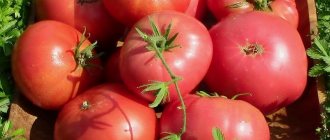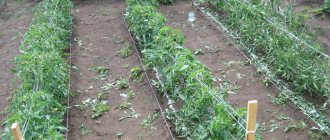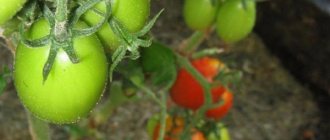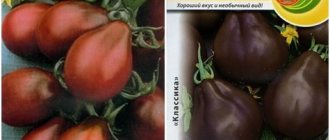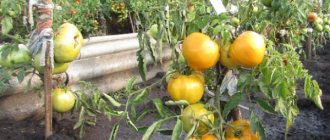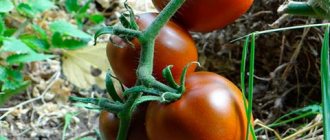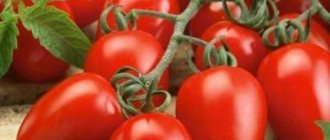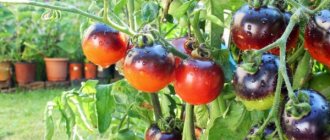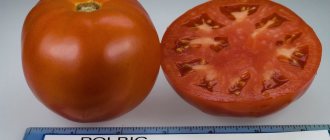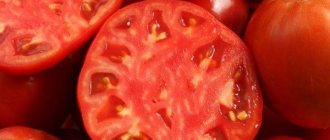Tomatoes are one of the most common and popular vegetable crops. They are grown both industrially and in private farmsteads. The modern assortment of this crop is diverse. There are varieties with fruits no larger than cherries, and there are huge tomatoes weighing one kg or more. The color of fruits when fully ripe can be green, yellow, red and even black.
The vegetable grower faces a difficult choice problem. The less land allocated for this crop in the garden, the more difficult it is to select productive, tasty and disease-resistant varieties. Let's try to find out what the f1 barge tomato is, a description of this hybrid and its cultivation features.
Growing seedlings
Tomato is sown as seedlings in the first ten days of April. More precise dates are chosen taking into account the climate of the area and growing conditions (in shelters, in open ridges). The seedlings should be 55-60 days old; staying at home longer affects plant productivity and reduces immunity.
Hybrid seeds are sold in bags in limited quantities. Therefore, it is advisable to immediately sow them in separate pots or cups, this way there is less loss. As they grow, add nutritious soil to the container and feed the seedlings 1-2 times with complex fertilizers.
Planting when stable heat sets in, in the middle zone - in May, in regions of harsh climatic conditions - no earlier than June 8-15. When planting in shelters, the planting time is approximately 10-15 days earlier.
Agricultural technology
How to calculate the time for sowing seeds
The date of sowing the seeds of this variety must be planned in such a way that by the time the tomatoes are planted in a permanent place, its age is 60-65 days from germination. It must be remembered that germination of seeds also takes time, as a rule, 5-7 days.
To determine the timing from which sowing time should be counted, it is important to take into account the characteristics of your region and future planting conditions (heated or unheated greenhouse, open ground).
It should be borne in mind that tomato is a southern and heat-loving crop. And despite the hardiness of the variety, sub-zero temperatures will lead to the death of plants. In the warm southern regions of Russia, the time for planting in a greenhouse is April 15-May 1. In the middle zone, the optimal time for transfer work will be from May 1 to May 15. But the main guideline for any part of Russia is still the air temperature; it should not be below 15 degrees during the day and below 10 degrees at night.
Planting seedlings
Tomatoes are planted according to the scheme - 3-4 plants per square meter. First, humus or well-rotted compost, ash, and superphosphate are added to the soil.
Burlak tomatoes grow well on ridges, under arches with covering material or film. After planting, the plants are protected from the sun's rays and quickly adapt to new conditions. Then, after about 8-10 days, the shelters are removed and the crop is grown in the open air.
On a note! According to numerous observations of experienced gardeners, tomatoes grown in beds have a good, rich taste.
How to care for seedlings
The appearance of the first green loops on the soil surface means that the germination stage has been successful, and the time has come to create a microclimate suitable for further normal growth. Containers with seedlings are placed in the brightest place in the room or artificially illuminated with phytolamps. The optimal air temperature for seed germination and comfortable human habitation is no longer suitable for seedlings. It is necessary to reduce the temperature to 15-16°C as soon as possible after emergence. With this regime, young plants will grow for another 2-3 weeks. If this is not done, the seedlings will turn into thin long stems with an undeveloped root system. A lower temperature, on the contrary, promotes the growth not of the above-ground part of the plant, but of the underground part, that is, the roots. At the same time, the first pair of leaves is formed without delay, and the seedling remains strong and stocky.
After 2-3 weeks, when the seedlings have grown, become stronger and have 2-3 true leaves, pick them. After transplanting the tomatoes into separate containers, the temperature regime is changed again. Now, for normal growth until transplantation to a permanent location, plants need an air temperature of around 18-20°C.
Further care consists of moderate watering with warm water and fertilizing if necessary. You can determine whether plants have enough nutrients by the appearance of the seedlings.
- So, if the leaves turn pale before your eyes, and the veins are clearly visible, it means that there is an iron deficiency. In this case, the bushes are sprayed with a solution of iron sulfate.
- If, with regular watering and good lighting, the plants look stunted and the leaves begin to turn yellow, this indicates a lack of nitrogen in the soil. In this case, the leaves of the seedlings are sprayed with a urea solution.
- Darkening of the leaves and the presence of a purple tint on their underside is a sure sign of a lack of phosphorus. In this case, root feeding with superphosphate will come to the rescue.
- The fragility of seedlings and signs of leaf curling indicate a lack of magnesium. This means it’s time to feed the seedlings with a solution of magnesium sulfate.
How to plant correctly in the ground
The characteristics of this variety do not allow compacted plantings. To obtain good results, it is necessary to strictly follow the recommended scheme and plant no more than four seedlings per square meter in case of formation in one stem and no more than three in case of formation in two stems. More frequent planting is not recommended due to the powerful root system of plants, as this leads to a reduction in the feeding area of each seedling and, as a result, a decrease in yield.
How to care for tomatoes after transplanting
The main features of caring for the Burlak Minusinsky tomato after transplantation are:
- Stepsonning and formation
Stepping is a mandatory and most labor-intensive procedure. It must be carried out in a greenhouse throughout the entire growing season, without allowing the stepsons to outgrow. In the process of removing side shoots, the formation of a bush occurs. Plants of this variety are formed into one or two main trunks. If the recommendations are not followed, the plants' gas exchange and moisture balance are disrupted and a lack of light and oxygen occurs.
- Tying up
This procedure is no less mandatory for plants. Tall tomatoes need support. These can be tall and stable stakes, wooden trellises or agricultural mesh. The bushes are tied up immediately from the moment of transplantation and continue to do this throughout the season as they grow. The materials for this must be strong, but soft, so as not to damage parts of the plants, and must also be disinfected or new.
- Lightening
Lightening involves regulating the vegetative mass of tomatoes. First of all, the lower leaves of the seedlings are removed. The time when this needs to be done will be determined by the appearance; the leaves will begin to turn yellow and wither. Throughout the growing season, leaves should be removed under each fruit cluster after the fruits have set on them. This reduces the load on the plant, improves ventilation and light access.
- Watering
In plants of this variety, the main roots go deep into the soil and a large number of roots are located near the surface of the earth; accordingly, watering should be rare but plentiful. It is important to ensure that the stream of water does not erode the soil around the plant trunk. The water temperature should not be lower than 22°C.
- Mulching
You can mulch the soil under the bushes immediately after transplanting them into a greenhouse or soil. Straw, mown grass, newspapers, and cardboard are suitable as mulch. This agricultural technique preserves the top layer of soil from drying out and from the growth of weeds.
- Topping
Pinching the crown of the stem is carried out a month before the onset of stable cold weather. In this case, 3-4 leaves are left above the last fruit cluster. This procedure allows all already set fruits to ripen.
Helpful advice! Tomatoes in a greenhouse need help pollinating flower clusters. To do this, the stems and twigs with flowers are carefully shaken, this helps the pollen to scatter well. It is important to carry out this procedure when the greenhouse is warm and dry.
Planting tomatoes in a permanent place
When the soil warms up to 10ºC... 12ºC, tomatoes can be planted in a greenhouse. In the middle zone, this time is the beginning or middle of May; in the northern regions, the dates shift slightly. Much depends on the weather, so you need to navigate specific conditions.
Requirements for seedlings:
- strong stem;
- height up to 18-22 cm;
- 6-8 true leaves;
- the first buds are present.
There is no need to rush with planting; the soil should warm up and the air temperature should be stable. At the same time, even in a greenhouse it is recommended to cover the seedlings with non-woven material so that the plants take root better.
The soil is prepared in advance by adding humus, potassium and phosphorus fertilizers. Superphosphate can be added one spoonful into each well.
We invite you to familiarize yourself with the Gazebos: >100 drawings, dimensions and step-by-step photos of assembly.
Indeterminate Burlak Minusinsky is planted three bushes per 1 square meter, no more. Only overgrown seedlings are buried; all other seedlings are planted at the same level as they grew in pots.
Tomatoes for open ground
When working with seeds, it is necessary to carry out disinfection
containers (boxes, seedlings). Hands should be wearing gloves or should be washed periodically and wiped with napkins. There are very frequent cases when the infection gets on the seeds due to insufficiently carefully treated containers. New containers must be washed; it is advisable to soak already used containers for a day in a deochlor solution, 1 tablet per 5 liters of water, and then rinse thoroughly.
Soil for seedlings
In soil you make yourself, with the addition of no more than 20% of purchased soil, tomatoes grow much better.
It is necessary to mix 35% peat, 20% purchased high-quality soil with fertilizers and microelements, 30% garden soil not from tomatoes, steamed to 60 degrees, 10% your own or purchased vermicompost, 4% perlite, 1% vermiculite.
Sown for seedlings from March 10-15 to March 30 - April 5, 45 -55 days before planting in closed ground. For open ground from April 10-15, 35-40 days (maximum 45 days) before planting seedlings.
The closer to bright and warm spring days you sow the seeds, the higher the solar activity, which means all phases of seedling development pass faster. Varieties and hybrids for open ground; it is not advisable to sow seedlings early. If weather conditions are unsuitable for planting in a permanent location, the seedlings may overgrow and lose their quality.
Sowing of seeds is carried out in seedling containers, at the bottom of which it is necessary to make drainage from fine charcoal,
and then pour 5-7 cm of well-mixed seedling soil. Level the soil. Make grooves 1 cm deep at a distance of 3 centimeters from each other. Moisten the soil from a spray bottle with a weak solution of potassium humate with microelements. Place tomato seeds in the grooves, lightly pressing them into the soil with a fingertip or a toothpick at a distance of 2-2.5 cm from each other. Once again lightly spray with a solution of humate (humate + 7 or humate + iodine) from a spray bottle, which stimulates and accelerates the growth process. Fill the top with a 0.5 cm layer of dry soil, which must then be carefully compacted (pressed against the base).
Seedling containers are covered with film to create a greenhouse effect and placed in a warm place with a temperature of + 28-30 degrees C. Hybrid tomato seeds are more demanding of heat during germination, unlike varietal ones. If the temperature conditions are not observed, the seeds may rot and not germinate or will germinate slowly and for a long time.
. With the emergence of seedlings, the temperature for the first 2-3 days is reduced to plus 15-18 degrees during the day and 10-12 degrees at night. This technique protects the seedlings from being pulled out and creates conditions for better development of the root system.
4-7 (maximum 10) days after germination, remove the film and place the tomatoes under 24-hour lighting for 3-5 days. Then the daylight hours for tomatoes should be at least 14 - 16 hours a day under lighting or on a light and warm, draft-free window sill.
A week after germination, the temperature regime is changed to plus 20-25 degrees during the day and 12-15 degrees at night. After 2 weeks from germination, the seedlings are planted in individual seedling containers.
Pour a 2 cm layer of fine charcoal into a 400 ml seedling container with drainage holes at the bottom. You can grind the charcoal for barbecue, which is sold in all stores. Add nitrogen-free complex fertilizer borofosk 1/5 teaspoon. It is phosphorus, boron and potassium that will participate in the formation of the first brush. Fill halfway with soil.
Use a teaspoon to remove the seedling from the container and transfer it to a container for seedlings. Cover the roots completely with soil, squeezing it carefully to prevent the formation of air pockets. Water the soil with a weak solution of calcium nitrate, 1/2 teaspoon per 1 liter of warm water. Add soil on top and do not water again. Place seedling containers in pallets and place them under lighting.
The next watering after picking is carried out after 5 days until the earthen clod is completely wetted. Then water only after the soil has completely dried. If the plants are slightly wilting, it is recommended to spray them with a weak solution of potassium humate or a weak solution (1/3 of the recommended dose) of a complete mineral complex for tomato seedlings,
but do not water until the earthen clod is completely dry. During the growth of seedlings, it is recommended to spray it 1-3 times per leaf with calcium nitrate, normally 1 teaspoon per 1 liter of warm water.
Before planting, our seedlings must be hardened off.
To do this, you need to reduce daytime temperatures to plus 13-15 degrees for several hours, and night temperatures to plus 6-8 degrees. After 50-60 days, our indeterminate tomato seedlings are ready for planting. Determinate ones are planted after 35-45 days. At the same time, the soil temperature should be above 12 degrees, and when planting in open ground, the likelihood of return frosts must be taken into account. Therefore, deadlines vary by region.
Growing seedlings without picking
Fill the disinfected boxes with soil, the height of the soil is 10 cm. Make rows at a distance of 10 cm from each other, moisten the soil from a spray bottle with a solution of any humate. Place the seeds in rows at a distance of 10 cm from each other. Spray lightly with humate again. Cover the boxes with film and take them out to a glassed-in loggia or greenhouse. Make a cover on top of non-woven covering material. When shoots appear, remove the film. To protect from night frosts and bright daytime sun, leave the seedlings under covering material. In case of frost, we recommend placing the film over the covering non-woven material at night. The film cannot be used during the day. Feeding and watering in the same mode as in the variant with picking.
Preparing the soil for planting
- In the spring, mineral fertilizers are applied to the ground where tomatoes are planted.
Per 1 square meter, 60 g of superphosphate, 60 g of potassium sulfate and 40 g of ammonium sulfate, which contains nitrogen and sulfur, which protect against ticks and diseases. The applied fertilizers are loosened with the soil. - It is necessary to prepare the planting grooves; this is more convenient than preparing each hole individually.
We prepare furrows 20-25 centimeters wide and 15-20 deep. If you are planting in several rows and your beds are wide, then the distance between the planting grooves should be at least 70 cm. - 2-3 days before planting, we apply nitrogen-free borophosphate fertilizer along the entire length of the planting furrow
(long-acting fertilizer slowly dissolves all summer under the influence of soil acids and friendly microorganisms) at the rate of 2 spoons per linear meter of the furrow and mix with the soil. - We shed the grooves with a solution of Trichodermin Veride or a solution of Baikal or a solution of Fitosporin.
Please note that Trichodermin + Baikal = combined complex, Fitosporin + Baikal = combined complex, it is not recommended to combine phytosporin and Trichodermin Veride in one area. After weeding the furrows, cover them with suitable material for 2-3 days before planting to preserve moisture.
Advantages and disadvantages of the hybrid barge hauler
The appearance of tomatoes of this type is the result of the painstaking work of breeders trying to develop hybrid forms that are easy to care for and productive. Burlak F1 attracts gardeners with its many “advantages”:
- productivity (up to 12-15 kg of fruits are harvested from one square meter);
- ease of care (shows excellent results when maintained in one stem);
- suitable for planting in hotbeds and greenhouses, bears fruit well in open ground;
- large fruits;
- good taste for early tomatoes.
The tomato is resistant to climate changes and does not shed ovaries during slight cold snaps or drought. Judging by the reviews of summer residents, it has performed well in regions of temperate climates and even in unfavorable seasons produces an excellent harvest of fruits.
“Disadvantages” – you cannot take your own seeds for sowing (first generation hybrid). Since Burlak F1 is produced by only one company, seeds are not always available in stores. If you want to plant this hybrid, you need to worry about the seeds in advance.
Description of the hybrid
Burlak F1 tomatoes were bred by Russian breeders. Orginator - seed material is available for sale in packages from only one manufacturer. This is a first-generation herbide (labeled F1), so it is necessary to purchase seeds for sowing every season.
On a note! Do not confuse Burlak F1 with another variety - Burlak Minusinsky. These are completely different tomatoes in their characteristics, so you should be careful when purchasing.
Features of agricultural technology of the Burlak Minusinsky tomato variety
It is recommended to grow this variety in a greenhouse (northern regions and middle zone), as the yield will be higher. The seedling method is used, taking into account the timing of planting seedlings in greenhouses. Usually for the middle zone it is the beginning or middle of May, for the North-West it is the end of May or the beginning of June.
Provided that the seedlings should be about 60-65 days old, you can calculate the sowing time. Burlak Minusinsky seeds are sown in March, having prepared containers for planting and soil in advance.
Features of cultivation, planting and care
photo author Natalya Ananyeva
Sowing the seeds of this variety of tomatoes for seedlings is carried out 60-65 days before the intended planting in the ground. Picking seedlings at the stage of 2 true leaves. When planting seedlings in a permanent place per 1 sq. It is recommended to place up to 3 bushes per meter of land, and up to 4 when forming 1 stem.
Further care for tomatoes consists of timely watering, fertilizing, pinching, weed removal and preventive measures to protect plants from diseases and pests.
If you grew Burlak Minusinsk tomatoes, please write whether you liked them or not. What was the yield and taste of the fruits in your climatic conditions? How do you rate the disease resistance of this tomato? If possible, attach a photo of the entire bush or individual fruits you grew. Thank you!
Your reviews of the Burlak Minusinsky tomato and additions to the description will help many gardeners evaluate this variety more objectively and decide whether it is worth planting or not.
The legendary Minusinsk tomatoes are the pride of Siberia and are known for their large size and excellent taste. Despite the fact that the register of breeding achievements in the Russian Federation has not recorded the collection of these tomatoes, they are all very popular among vegetable growers.
One of these favorites of popular selection is the early-ripening, high-yielding variety “Burlak Minusinsky”.
Advantages and disadvantages
Growing a Burlak F1 tomato, like any other, has its advantages and disadvantages. However, the manufacturer provides relatively little information about this hybrid, so it can only be judged by the reviews of experienced gardeners. Here's what they say about the benefits of tomato:
- Really large fruits, which is quite unusual for an early-ripening hybrid.
- Quite high yield.
- Thanks to the unusual shape of the leaf, it stands out noticeably in the garden bed - there is no need to make special markings, and in general it looks very aesthetically pleasing.
- Can be grown both in open ground and in a greenhouse.
- Suitable for cold regions.
- The taste of tomatoes is sweet, the flesh is fleshy.
Tomatoes also have disadvantages. Here is their list:
- There is relatively little information on the manufacturer's packaging and not all of it corresponds to reality! According to some reviews, the shape of the fruit does not correspond to the declared one: instead of flat-round, they received elongated, plum-shaped, completely smooth ones.
- The average fruit size is not 500 g, but 400 g. Maximum weight can only be achieved in a greenhouse!
- This hybrid is not included in the state register and is produced only by the company Gardens of Russia.
We suggest you read How to grow roses at home in a pot
Tomato barge f1 description
Tomatoes are one of the most common and popular vegetable crops. They are grown both industrially and in private farmsteads. The modern assortment of this crop is diverse. There are varieties with fruits no larger than cherries, and there are huge tomatoes weighing one kg or more. The color of fruits when fully ripe can be green, yellow, red and even black.
The vegetable grower faces a difficult choice problem. The less land allocated for this crop in the garden, the more difficult it is to select productive, tasty and disease-resistant varieties. Let's try to find out what the f1 barge tomato is, a description of this hybrid and its cultivation features.
Advantages and disadvantages of the variety
Minusinsk tomatoes have long been famous for their good qualities. The city of Minusinsk even hosts a citywide festival of Minusinsk tomatoes every year. Burlak Minusinsky, like other varieties bred by Siberian breeders, has its own advantages:
- early maturation;
- good yield;
- excellent tomato taste;
- large fruits;
- resistance to temperature changes.
This tomato has no obvious shortcomings. But it is worth noting that Burlak, like all indeterminate varieties, is not for lazy gardeners, since the bushes require constant shaping, pinching and staking.
Advantages and disadvantages of the Minusinsky barge barge variety
The fame of Minusinsk tomatoes has been going on for a long time; many summer residents are already growing tomatoes from their own seeds. The Burlak Minusinsky variety is valued for its productivity and very tasty fruits.
What other “advantages” does this tomato have:
- unpretentiousness;
- large fruits (on average 400-500 grams);
- high presentation of tomatoes;
- early ripening;
- disease resistance.
This variety is perfect for preparing salads, juices and sauces, so housewives will have plenty of room to roam. The fruits do not crack and are quite resistant to temperature changes and uneven watering.
There are no disadvantages noted, but it is recommended that more attention be paid to the formation of the bush and the installation of supports. In greenhouses it is convenient to grow a tall variety with the help of trellises, since the stems and branches of Burlak are not particularly strong and powerful.
When using a trellis, the branches are fixed, the possibility of creases is eliminated, and the tomato also receives uniform illumination.
Folk selection rules
The variety belongs to the so-called folk selection tomatoes, but the lack of regalia of various research institutes and agricultural firms does not affect its popularity. Moreover, Burlak Minusinsky can compete in the excellent quality of fruits and unpretentiousness with many varieties “promoted” by the management of producing companies.
This is an early ripening tomato that is recommended to be grown in a greenhouse. It is part of the indets group, its growth is unlimited and this must be taken into account when planting. The usual height of the plant is 180 cm, it grows even higher - up to 200-220 cm.
ON A NOTE! This variety requires mandatory support and bush formation.
The plants are medium-leaved, potato leaves, wide. It is recommended to strictly follow the planting scheme, growing no more than three plants of this tomato variety per square meter. When plantings are compacted, the yield will be lower.
Tomatoes have a beautiful, flat-round shape. Large fruits hang like apples on the branches of the bush, so all the clusters are often additionally tied up. The weight of tomatoes is from 350 to 600 grams. The skin is dense, raspberry-red in color. The fruits of this tomato have characteristic ribbed “shoulders” near the stalk.
Burlak Minusinsky is praised by everyone for its taste and excellent yield. Its pulp is sugary; droplets of juice are even visible at the break. The tomato is sweet, with a characteristic aroma. Can be used for preparing salads, juices, purees, various sauces.
The variety is part of the collection of the famous gardener from the Kurgan region, Valentina Redko, who recommends Burlak Minusinsky to everyone who wants to get tasty and productive tomatoes.
From one bush you can remove up to 5-6 kg of delicious tomatoes - large, sweet, beautiful.
Caring for tomato barge minusinsk
For about 10 days, do not touch the seedlings, do not water them, do not fertilize them, just watch the growth of the seedlings. This is the time for tomatoes to adapt and build up the root system.
Supports for the garter must be installed in the greenhouse in advance. When grown on trellises, tomatoes are carefully secured to the wire as they grow. If the supports are individual for each bush, then bandages and strips of cotton fabric are used as garters. It is not recommended to use ropes or twine as they will cut the plant stems.
Harvesting tomatoes
The fruits in the greenhouse are reliably protected from sudden temperature changes and cold dew, so there is no urgent need to remove the entire crop at the stage of milk maturity for ripening at home. You can do this little by little in order to stimulate the formation of new ovaries. As autumn approaches, already set fruits can be left to ripen on the bush if the air temperature does not drop below 8°C.
It is enough to harvest tomatoes at the beginning of fruiting once every five days, at the height of the season once every two or three days, preferably in the morning. If, however, the fruits are collected for ripening at home, they are placed in baskets or boxes lined inside with natural fabric. To speed up ripening, add a couple of ripe ones to unripe fruits. They will release ethylene and significantly reduce the ripening time.
Reviews from summer residents
Tomato Burlak has collected quite a large number of reviews about itself, some of which are quite contradictory. However, each of them is an invaluable gardening experience that you can use to your advantage:
- Elena. Burlak F1 gave excellent results! Previously, I had never collected tomato fruits larger than 300 g from my beds, but here everything is just like a selection, now this variety is among my favorites!
- Anna. The appearance of the fruits of the Burlak hybrid does not at all correspond to the photo on the packaging; they look more like large cream. Unfortunately, the taste was also not pleasing: there was little sweetness, and the flesh was watery. I won't plant any more.
- Elena. I planted the Burlaka seedlings in early June, fed them a couple of times, and did not plant them very responsibly, but I was still pleased with the result! I highly recommend this variety!
- Alexei. We have been planting Burlak from Gardens of Russia for several years now, they always have bushes no smaller than 1.2 - 1.4 in size! We often buy seedlings and seeds from this manufacturer; unfortunately, there are mismatches. But we’ve never gotten into trouble with tomatoes. In terms of fruit, the tomato corresponds to the declared characteristics. I like this variety, it’s a pity that there are not enough seeds in the bag - about 15, there used to be more.
https://www.youtube.com/watch?v=PHyOlHjgbBA
Tomato Burlak is an excellent early-ripening hybrid with good yield and large fruits, good for cold regions. With proper care and compliance with agricultural technology, it can become one of the favorites. However, there are quite a lot of alternatives to this variety with more attractive characteristics, especially when it comes to the southern regions.
